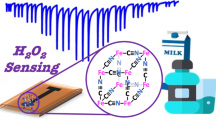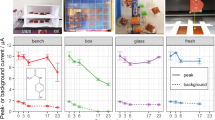Abstract
Flexible self-supported laser-induced graphene (LIG) electrode devices were facilely fabricated through laser ablation technique by employing commercial polyimide film as the precursor material. Compared with the widely used traditional glassy carbon electrodes, the resulted LIG electrodes displayed abundant porous structure and surface defects. Notably, the one-step yielded LIG electrode devices were endowed with large electrochemically active surface area and accelerated electron transfer ability. Benefiting from its superior electrochemical property, these unmodified LIG electrodes exhibited remarkable enhanced electrochemical oxidation reactivity toward the food additive molecule Allura Red. Based on the augmented oxidation signal of Allura Red molecules on the LIG electrodes, a novel electrochemical sensor with high sensitivity for the detection of Allura Red was successfully developed. The sensor demonstrated a linear detection range spanning from 5 nM to 1 μM and exhibited a detection limit as low as 2.5 nM. Besides, the sensitivity was calculated to be 240.62 µA μM−1 cm−2. More importantly, the sensor manifested outstanding stability, reproducibility, and practicality, further emphasizing its potential for real-world application.








Similar content being viewed by others
Data availability
Data will be made available on request.
References
Buckley D, Black N, Castanon E, Melios C, Hardman M, Kazakova O (2020) Frontiers of graphene and 2D material-based gas sensors for environmental monitoring. 2D Mater 7:032002
Pumera M (2011) Graphene in biosensing. Mater Today 14:308–315
Parate K, Pola C, Rangnekar S, Mendivelso-Perez D, Smith E, Hersam M, Gomes C, Claussen J (2020) Aerosol-jet-printed graphene electrochemical histamine sensors for food safety monitoring. 2D Mater 7:034002
Shi S, Zhong R, Li L, Wan C, Wu C (2022) Ultrasound-assisted synthesis of graphene@MXene hybrid: a novel and promising material for electrochemical sensing. Ultrason Sonochem 90:106208
Tang S, Li C, Li L, Huang J, Wang B, Zhong R, Tang Y, Wu C, Wu K (2023) Graphene/metal-organic framework nano-sandwiches derived N, P-codoped porous carbon nanosheets as robust material for electrochemical analysis. Anal Chim Acta 1277:341675
Shi S, Cao G, Chen Y, Huang J, Tang Y, Jiang J, Gan T, Wan C, Wu C (2023) Facile synthesis of core-shell Co-MOF with hierarchical porosity for enhanced electrochemical detection of furaltadone in aquaculture water. Anal Chim Acta 1263:341296
Min X, Li L, Zhong R, Wan C, Wu C (2022) MOF-derived porous nitrogen and phosphorus codoped carbon nanosheets: an emerging material for constructing robust electrochemical sensing platform. Sens Actuat B-Chem 369:132263
Zhao G, Wang T, Li L, Tang Y, Qin Q, Wu C (2021) Heteroatoms doped yolk-shell hierarchically porous carbon derived from ZIF-8 for electrochemical sensing. Carbon 183:291–300
Geim A (2009) Graphene: status and prospects. Science 324:1530–1534
Dreyer D, Park S, Bielawski C, Ruoff R (2010) The chemistry of graphene oxide. Chem Soc Rev 39:228–240
Zhu Y, Murali S, Cai W, Li X, Suk J, Potts J, Ruoff R (2010) Graphene and graphene oxide: synthesis, properties, and applications. Adv Mater 22:3906–3924
Bonaccorso F, Colombo L, Yu G, Stoller M, Tozzini V, Ferrari A, Ruoff R, Pellegrini V (2015) Graphene, related two-dimensional crystals, and hybrid systems for energy conversion and storage. Science 347:1246501
Shen Y, Fang Q, Chen B (2015) Environmental applications of three-dimensional graphene-based macrostructures: adsorption, transformation, and detection. Environ Sci Technol 49:67–84
Kumar S, Chatterjee K (2016) Comprehensive review on the use of graphene-based substrates for regenerative medicine and biomedical devices. ACS Appl Mater Interfaces 8:26431–26457
Wu C, Sun D, Li Q, Wu K (2012) Electrochemical sensor for toxic ractopamine and clenbuterol based on the enhancement effect of graphene oxide. Sens Actuat B-Chem 168:178–184
Wu C, Cheng Q, Wu K (2015) Electrochemical functionalization of N-methyl-2-pyrrolidone-exfoliated graphene nanosheets as highly sensitive analytical platform for phenols. Anal Chem 87:3294–3299
Wu C, Cheng Q, Wu K, Wu G, Li Q (2014) Graphene prepared by one-pot solvent exfoliation as a highly sensitive platform for electrochemical sensing. Anal Chim Acta 825:26–33
Yang Z, Gao R, Hu N, Chai J, Cheng Y, Zhang L, Wei H, Kong E, Zhang Y (2012) The prospective two-Dimensional graphene nanosheets: preparation, functionalization, and applications. Nano-Micro Lett 4:1–9
Ye R, James D, Tour J (2018) Laser-induced graphene. Acc Chem Res 51:1609–1620
Chyan Y, Ye R, Li Y, Singh S, Arnusch C, Tour J (2018) Laser-induced graphene by multiple lasing: toward electronics on cloth, paper, and food. ACS Nano 12:2176–2183
Ye R, James D, Tour J (2019) Laser-induced graphene: from discovery to translation. Adv Mater 31:1803621
Wang L, Li M, Li B, Wang M, Zhao H, Zhao F (2023) Electrochemical sensor based on laser-induced graphene for carbendazim detection in water. Foods 12:2277
Qiu D, Wang X, Wen Y, Zeng Y, Li W, Zhao L, Chen L, Xiong J, Tang K (2022) A low-cost wireless intelligent portable sensor based on disposable laser-induced porous graphene flexible electrode decorated by gold nanoshells for rapid detection of sulfonamides in aquatic products. Food Anal Method 15:1471–1481
Doguc D, Ceyhan B, Ozturk M, Gultekin F (2013) [1]effects of maternally exposed colouring food additives on cognitive performance in rats. Toxicol Ind Health 29:616–623
Yoshioka N, Ichihashi K (2008) Determination of 40 synthetic food colors in drinks and candies by high-performance liquid chromatography using a short column with photodiode array detection. Talanta 74:1408–1413
Tang T, Xu X, Wang D, Zhao Z, Zhu L, Yang D (2015) A rapid and green limit test method for five synthetic colorants in foods using polyamide thin-layer chromatography. Food Anal Method 8:459–466
Huang H, Shih Y, Chen Y (2002) Determining eight colorants in milk beverages by capillary electrophoresis. J Chromatogra A 959:317–325
Wang S, Zhang L, Jin Q, Xu Z, Zhao J, Ding Y, Li W, Lin P, Gu J, Zhang Q, Chen Y, Chen H, Yan T (2022) Filter paper-based colorimetric analysis: an instrument-free strategy for semiquantitative naked-eye detection of food colorants. Food Chem 390:133087
Vijeata A, Chaudhary S, Chaudhary G (2022) Fluorescent carbon dots from Indian Bael patra as effective sensing tool to detect perilous food colorant. Food Chem 373:131492
Zhang Y, Zhang X, Lu X, Yang J, Wu K (2010) Multi-wall carbon nanotube film-based electrochemical sensor for rapid detection of Ponceau 4R and Allura Red. Food Chem 122:909–913
Mehmandoust M, Pourhakkak P, Hasannia F, Ozalp O, Soylak M, Erk N (2022) A reusable and sensitive electrochemical sensor for determination of Allura red in the presence of Tartrazine based on functionalized nanodiamond@SiO2@TiO2; an electrochemical and molecular docking investigation. Food Chem Toxicol 164:113080
Silva T, Wong A, Fatibello O (2020) Electrochemical sensor based on ionic liquid and carbon black for voltammetric determination of Allura red colorant at nanomolar levels in soft drink powders. Talanta 209:120588
Yu L, Shi M, Yue X, Qu L (2016) Detection of allura red based on the composite of poly(diallyldimethylammonium chloride) functionalized graphene and nickel nanoparticles modified electrode. Sens Actuat B-Chem 225:398–404
Cheng Q, Xia S, Tong J, Wu K (2015) Highly-sensitive electrochemical sensing platforms for food colourants based on the property-tuning of porous carbon. Anal Chim Acta 887:75–81
Pliuta K, Snigur D (2022) Determination of Allura Red AC with a β-cyclodextrin-modified carbon paste electrode. ChemistrySelect 7:e202203070
Vargas-Varela A, Cardenas-RiojasA NE, Hurtado J (2023) Detection of Allura Red in food samples using carbon paste modified with lanthanum and titanium oxides. ChemistrySelect 8:e202204737
Gan T, SunJ ZhuH, ZhuJ LD (2013) Synthesis and characterization of graphene and ordered mesoporous TiO2 as electrocatalyst for the determination of azo colorants. J Solid State Electr 17:2193–2201
Nagles E, Ceroni M, Huerta C, Hurtado J (2021) Simultaneous electrochemical determination of paracetamol and Allura Red in pharmaceutical doses and food using a Mo(VI) oxide-carbon paste microcomposite. Electroanal 33:2335–2344
Penagos-Llanos J, Garcia-Beltran O, Calderon J, Nagles E, Hurtado J (2019) Carbon paste composite with Co3O4 as a new electrochemical sensor for the detection of Allura Red by reduction. Electroanal 31:695–703
Acknowledgements
This work was financially supported by National Natural Science Foundation of China (Nos. 22174033, 21804031, 22176162).
Author information
Authors and Affiliations
Contributions
YZ: methodology, conceptualization, software, visualization, validation, and writing—original draft. YT: methodology, visualization, validation, and writing—review & editing. TG: methodology and visualization. CW: supervision, formal analysis, writing—review & editing, funding acquisition, and project administration.
Corresponding authors
Ethics declarations
Conflict of interest
The authors declare that they have no known competing financial interests or personal relationships that could have appeared to influence the work reported in this paper.
Additional information
Publisher's Note
Springer Nature remains neutral with regard to jurisdictional claims in published maps and institutional affiliations.
Rights and permissions
Springer Nature or its licensor (e.g. a society or other partner) holds exclusive rights to this article under a publishing agreement with the author(s) or other rightsholder(s); author self-archiving of the accepted manuscript version of this article is solely governed by the terms of such publishing agreement and applicable law.
About this article
Cite this article
Zeng, Y., Tang, Y., Gan, T. et al. Flexible self-supporting laser-induced graphene electrode devices for highly sensitive electrochemical analysis of Allura Red. Carbon Lett. 34, 985–995 (2024). https://doi.org/10.1007/s42823-023-00636-7
Received:
Revised:
Accepted:
Published:
Issue Date:
DOI: https://doi.org/10.1007/s42823-023-00636-7




